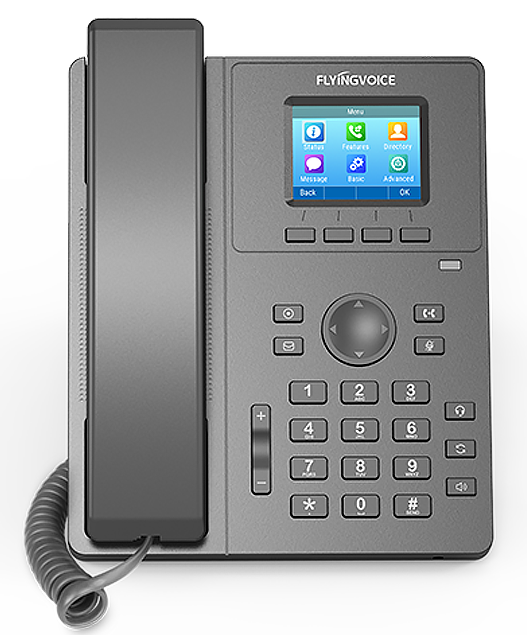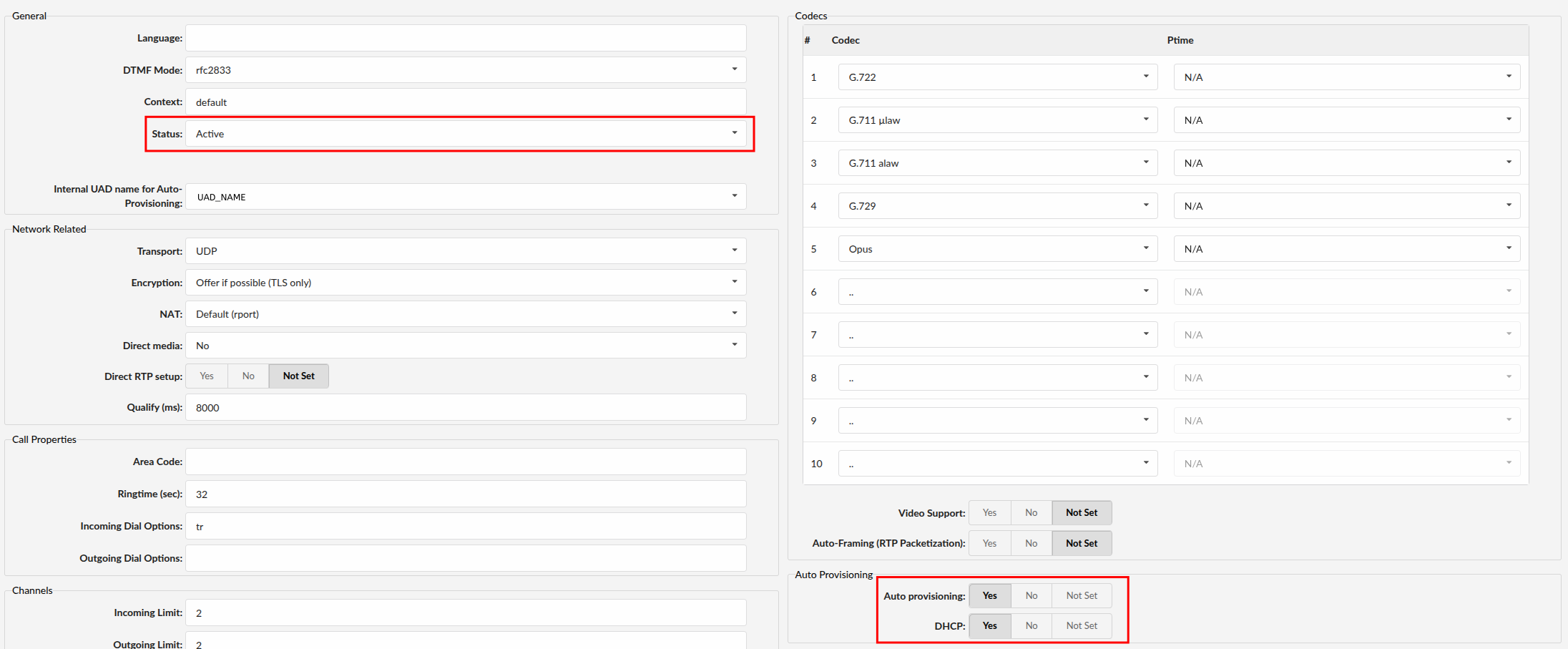¶ Introduction

This configuration guide explains how to configure the Flyingvoice P11 phone model to work with PBXware v7.6.0.
¶ Requirements
¶ Identifying the Phone Model
To ensure a successful registration, first confirm that you have the correct Flyingvoice phone model.
The model information can be found on the back of your Flyingvoice phone. This guide is designed for the Flyingvoice P11. Other models may require different configuration steps, so verifying you have the P11 ensures proper setup.
¶ Phone Firmware
- Ensure your phone has the appropriate firmware version: 0.12.12
- To check the firmware version of your Flyingvoice phone, open a browser window and enter the phone's IP address to access the web administration interface. Example:
http://192.168.1.22 - Log in using the factory default credentials: username admin and password admin.
- Click the Status tab on top navigation menu and go to the Basic page.
- The Firmware Version field will show the current firmware version.
¶ DHCP Server
Fully configured and operational DHCP server.
¶ PBXware Version
PBXware version: 7.6.0
To check the PBXware version:
- Log in to PBXware
- Navigate to Settings: About.
At the top of the About page, you will see a code block similar to this:
PBXware Edition: Multi-Tenant, Release: 7.6 (387597b7), Running: 18.15.0.-gc-b47edc45, PBXware Proxy v7.6 (62b7bcd), API: 7, libmemcached version: 1.0.18
The Release field indicates the exact version of your PBXware.
¶ Installation
This section describes how to connect the phone to power and the data network, as well as how to apply factory settings.
Topics covered:
- Power and Network Connection
- Factory Settings
¶ Power and Network Connection
- Connect the DC plug on the power adapter to the DC port on the phone and connect the other end to a power outlet.
- Connect the Ethernet cable between the Internet port on the phone and a network port on your router or switch.
¶ Find the Phone's IP Address
- Click the Home button on the phone.
- Navigate to Status.
- The phone's IP address will be displayed in the IPv4 section.
¶ Reset to Factory Settings
This step is not required for brand new, out-of-the-box phones. However, if the phone has alredy been used, it is required.
- Open a browser window and enter the phone's IP address to access the web administration interface. Example:
http://192.168.1.22 - Log in using the factory default credentials: username admin and password admin.
- Click the Administration tab on the top navigation menu and go to the Management page.
- Go to the Factory default section and click the Factory Default button.
- You will see the following notification: "After restoring factory default settings or uploading configuration files, click on REBOOT to ensure they are activated!"
- Click the Reboot button.
- After reboot, all settings will return to defaults.
NOTE: Do not unplug or remove power from the device while the factory reset process is in progress.
¶ Registering the Phone
This section describes how to identify the Flyingvoice phone model, requirements that must be met, and how to register the phone using manual configuration or auto-provisioning.
The following topics are covered:
- Manual Configuration
- Auto Provisioning
¶ Manual Configuration
This section describes how to set the UAD settings, create a PBXware Extension, and register the phone.
The following topics are covered:
- UAD Settings
- Creating an Extension
- Registering the Phone
¶ UAD Settings
1. Log in to PBXware's web administration interface
- Open a new browser window and enter the PBXware IP address to access the administration login screen. Example:
http://192.168.1.10 - Log in to PBXware with your e-mail address and password.
2. UAD settings
- Navigate to Settings > UAD.
- Ensure that the Flyingvoice P11 UAD is enabled. To check the UAD status, click the Edit icon corresponding to the Flyingvoice P11 phone.
- Verify that Status is set to Active, Auto provisioning is set to No, and DHCP is set to Yes.
- Click the Save button.

¶ Creating an Extension
1. Add Extension
-
Navigate to Extensions, then click Add Extension.
-
The standard options window will open.
-
Select the Flyingvoice P11 phone model from the UAD dropdown menu.
-
Select the Location: Local or Remote.
- Local is for all Extensions registered on the LAN
- Remote is for all Extensions registered from remote networks, WAN, Internet etc.. -
Click the Next step button.
2. Extension Values
Enter values into the required fields:
REQUIRED FIELDS:
- Name
Enter a name for the Extension being created. Example: John Smith
Enter the e-mail address associated with this Extension. This e-mail address will receive all system notification messages. Example: john.smith@bicomsystems.com
- Click the Save button.

¶ Registering the Phone
This section describes how to register the Flyingvoice phone using Hostname or IP Address.
¶ Hostname or IP Address
Log in to the phone's web administration interface
-
Open a browser window and enter the phone's IP address to access the login screen. Example:
http://192.168.1.22 -
Log in using the factory default credentials: username admin and password admin.
-
Click SIP Account -> Line 1.
-
Enter the following details:
REQUIRED FIELDS:
- Line Enable
Enable this option.
- Display Name
PBXware Extension user name. Example: John
- Account
PBXware Extension number. Example 1003
- Phone Number
Same number as the Account.
- Password
The Secret of the Extension as received in the e-mail associated with this extension. Example: _%Z4M3*Ts9y7
A password is generated automatically for each newly created Extension.
- Proxy Server
Enter the Hostname or IP Address of PBXware.
- Example of a Hostname: voip.bicomsystems.com
- Example of an IP Address: 192.168.1.10
- Click the Save & Apply button at the bottom of the page.
- If everything is done as described above, you should have successfully registered your phone to PBXware.
- Dial *123 to verify registration.
¶ Auto Provisioning
This section describes how to set UAD settings, create a PBXware Extension, and register the phone using DHCP or Static IP address.
The following topics are covered:
- UAD Settings
- Creating an Extension
- Registering the Phone
¶ UAD Settings
1. Log in to PBXware's web administration interface
- Open a browser window and enter the PBXware IP address to access the web administration login screen. Example:
http://192.168.1.10 - Log in to PBXware with your e-mail address and password
2. UAD settings
- Navigate to Settings > UAD.
- Ensure that the Flyingvoice P11 UAD is enabled. To check the UAD status, click the Edit icon corresponding to the Flyingvoice P11 phone.
- Verify that Status is set to Active, Auto provisioning is set to Yes, and DHCP is set to Yes.
- Click the Save button.

¶ Creating an Extension
1. Add Extension
-
Navigate to Extensions, then click Add Extension.
-
The standard options window will open.
-
Select the Flyingvoice P11 phone model from the UAD dropdown menu.
-
Select the Location: Local or Remote.
- Local is for all Extensions registered on the LAN
- Remote is for all Extensions registered from remote networks, WAN, Internet etc. -
Click the Next step button.
2. Extension values
Enter values into the required fields:
REQUIRED FIELDS:
- Name
Enter a name for the Extension being created. Example: John Smith
Enter the e-mail address associated with this Extension. This e-mail address will receive all system notification messages. Example: john.smith@bicomsystems.com
- Auto Provisioning
Set to Yes.
- MAC Address
Enter the MAC address of the Flyingvoice phone. Example: 001565FF1536
NOTE: The MAC address can be found on the label at the back of the phone.
- Click Save.

¶ Registering the Phone
This section describes how to register the Flyingvoice phone using TFTP, or HTTP & HTTPS.
¶ TFTP or HTTP or HTTPS
-
Open a new browser window and enter the phone's IP address, e.g.
http://192.168.1.22 -
Log in using the factory default credentials: username admin and password admin.
-
Click the Administration tab on the top navigation menu and go to the Provision page.
-
Enter the Auto Provisioning username and password into the User Name and Password fields.
-
Choose the server type you intend to use: HTTP, HTTPS or Trivial FTP.
NOTE: Our recommendation is to use HTTP. -
If you decide to use HTTP, enter http:// followed by Hostname or IP Address, then followed by /prov in the Profile Rule field.
Example of a Hostname using HTTP: http://abc.bicomsystems.com/prov
Example of an IP Address using HTTP: http://192.168.1.10/prov
- If you decide to use HTTPS, enter https:// followed by Hostname or IP Address, then followed by /prov in the Profile Rule field.
Example of a Hostname using HTTPS: https://abc.bicomsystems.com/prov
Example of an IP Address using HTTPS: https://192.168.1.10/prov
- If you decide to use TFTP, enter tftp:// followed by Hostname or IP Address in the Profile Rule field.
Example of a Hostname: tftp://voip.bicomsystems.com
Example of an IP Address: tftp://192.168.1.10
- Click the Save & Apply button at the bottom of the page.
- Wait for the configuration to update. NOTE: Do not power off your phone during this process.
- The auto-provisioning process will start during the phone's reboot process. The phone will download the appropriate configuration file from PBXware.
- If everything is done as described above, you should have successfully registered your phone to PBXware.
- Dial *123 to verify registration.
¶ Additional Configuration Template
To include additional UAD configuration for Flyingvoice P11, add fields to the User Agent General Auto Provisioning Template in the Settings -> UAD -> Flyingvoice P11 menu, or add them directly to the Extension in the UAD Auto Provisioning Template section.